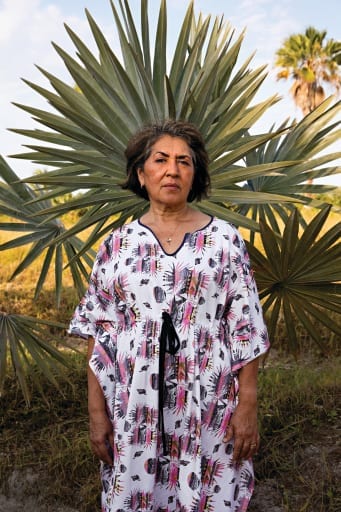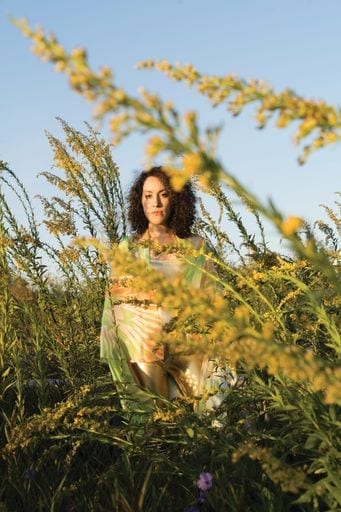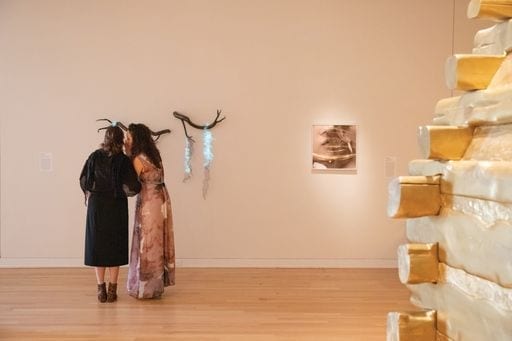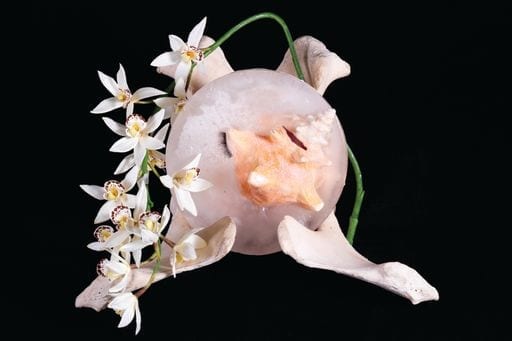Surrounded by the women in her family and dressed in matching garments, Cristina Molina’s grandmother reaches for a hand of support while precariously stepping from tall rock to ground. Molina has invited every female from both her matrilineal and patrilineal families to gather in the Florida subtropics in collaboration on a series of still-life photographs, portraits, and cinematic imagery. The idea for The Matriarchs project came about upon two untimely discoveries for the artist. At the same time of reading that her hometown Miami was at severe risk of rising sea levels, she was also learning that her grandmother was diagnosed with dementia. The dual erosion of her grandmother’s memory and the motherland that she grew up in roused an urgency in the artist to document her family legacy amid the disappearing landscape. “It’s not only about honoring us and our family, but also contemplating loss in general within those two very sensitive topics,” she explains.
The women all came willingly—her mother, aunts, cousins and grandmothers—out of love and respect for the artist. It was also something they had grown accustomed to: Molina always had a camera in her hand as a young adult discovering her artist identity. Against tropical greenery and under the South Floridian sunlight, she staged the women in complicated arrangements that allude to the dynamics that exist between women in family units.


“I was looking at these turn-of-the-century images of human pyramids in the circus thinking about how we could create hierarchy with our body and how I could display or demonstrate tension and balance,” she said. “It’s support but also strain.”
The positioning was indeed strenuous for the eldest women of her family, and though there was no hesitation, Molina could not help but experience an ethical dilemma. Was she exploiting her family for the sake of her art? What she ended up discovering while photographing her two grandmothers, including one who is bedridden, was quite the opposite. Molina asked “Is this okay?” and “How do you feel?” and her grandmother responded, “I feel like a queen.”
Being raised by this solid foundation of women was an undoubtable inspiration to Molina, whose work centralizes the female protagonist.
“In history, a lot of narratives about women have been obscured. I’m interested in reviewing those narratives and retelling those stories from a woman’s perspective that empowers a female voice,” she said.
In an effort to upend the traditional female subject who is ofttimes devastated or saved by her male counterpoint, Molina creates revisionist histories that present strong femme protagonists with brazen power that are set among landscapes both real and imagined.
While growing up in South Florida to immigrant families (her mother is from Cuba and her father from El Salvador), the artist was surrounded by a myriad of creative women, which grew in her a deep seated appreciation for craft. She was first trained in the dramatic arts in high school, but what truly piqued her interest was photography.
That really changed my world,” she says, “the wonderful alchemy of making images you don’t see and then having them appear before you in the dark. That was really special.”
Nonetheless, performance survived as a fundamental method within her practice, alongside video, installation, photography and textile design. “I think about the body, and gesture, and how you can communicate ideas of unity, struggle, and intimacy. I think that could be from my training in theater and that sometimes one of the more empathetic approaches is to captivate an audience through the body because it creates a connection of giving.”
Molina is preoccupied with the viewer. She chuckles, “I’m like a deviant hostess. I’m always thinking about how the viewer can encounter the work, how can I captivate them, and then how can I make them my hostage.”
During Ear to the Ground at the New Orleans Museum of Art in 2018, Molina led visitors through a one-on-one exploration of the exhibition in an onsite performance titled Under Three Things. In this intimate experience, she personified the mythical queen of the underworld, Persephone, but reimagined herself as an empowered goddess who whispered a narrative of an imagined underground landscape where each artwork constituted its topography. Beyond NOMA, Molina’s work has also been featured at the New Orleans Contemporary Arts Center, The Ogden Museum of Southern Art, The Polk Museum, New Orleans Film Festival, and Syros International Film Festival.
Continuing her studies, she earned her M.F.A. in art and technology from the University of Florida but not before completing a B.A. in psychology and B.F.A. in studio art from Florida International University. Molina ascribes the analytical aspects of her work to her understanding of psychology.

“I tend to privilege idea over form first, and a lot of the work begins with writing, and then I think about what I want the form to be afterward.” She continues, “I like to work in a constellation where there’s not necessarily one thing, but a series of things that all support each other, and I’m giving the viewer clues to solving the puzzle.”
Immediately following graduate school, Molina was hired as the associate professor of new media & animation at Southeastern Louisiana University in New Orleans, where she has lived for the past eight years. It was crucial for the artist to build a community around individuals who promote culture and share opportunities to create. Since 2014, Molina has been a member of the New Orleans artist-run project, The Front, where she regularly curates and exhibits artwork. “Part of my individual mission has always been to show other women’s work and to give other women as many opportunities as I can through [my role at The Front].” It was here that Molina met Vanessa Centeno, Robyn LeRoy-Evans and Ryn Wilson, three likeS minded feminist artists who formed the collaborative “The Crystal Efemmes.” Collectively, they share the mission of rewriting maledominated histories through storytelling, video and performance. “We became a family that transcends just art-making. It’s a sisterhood.”
In a recent multimedia installation titled The Fall, which took place at The Front, the collaborative reimagined The Garden of Eden as a site of paradise where “The Fall of Man” never occurred. “The Fall was about reframing the moment when Eve takes the apple so that she can still remain in paradise—reversing the idea that the reason for the fall of man was because a woman made a bad choice,” says Molina. “We wanted to reframe the aspect of choice as something to be celebrated and honored, not to be ashamed about.”
Visitors were invited to delight in the abundance of The Garden by exploring four chapters of the story, each as its own separate room filled with paradisiacal imagery, colorful fabric installations, whispering water elements and video projections. To support the project, the women held performative dinners where guests were seated within the space and served food cited in mythical lore as dangerous or forbidden while listening to spoken word.
Though Molina has certainly embedded herself within the New Orleans community, she has never truly left her hometown, always keeping one foot back in Miami to visit family and develop ideas about the vulnerable coastal landscape. She smiles, “Sometimes it takes you moving away from the place where you’re from to really see it.”
She often road trips back to Florida with her husband and fellow artist, Jonathan Traviesa, who also hails from the Southern state. The artistic duo began to recognize a peculiar quality about this popular “paradise,” which touts illusions of utopian fantasy.

“We always joke that people come to Florida to flee, to retire or to die,” she laughs. “We became invested in researching these utopian communities who move to Florida. We travel around to different sites in our home state looking—and it wasn’t very difficult to find—for these various aspirational images about paradise.”
Inspired by the title of Claude Levi-Strauss’s book Tristes Tropiques, the couple has been exhibiting and evolving a body of work called Sad Tropics for the past three years, which encompasses video animations, site-specific photo murals and various quirky yet recognizable consumer objects. With imagery of sunlit beaches, lush foliage, bananas and tricked out limousines, viewers experience a cross between tropical bliss and a beachside gift shop, both celebrating and critiquing the eccentricities of the Floridian culture.
Sad Tropics was featured in Art in America and Burnaway as one of the top exhibitions of the year to visit in 2016. And this year, Molina was one of 60 artists selected for the national exhibition State of the Art 2020 at the Crystal Bridges Museum of American Art. Currently she is working on a project called Never Glades that is situated within the Everglades territory in South Florida.
“I’m interested in retelling the story of the Women’s Clubs of South Florida, which were responsible for sanctioning the Everglades as a protected site,” says Molina. “What’s remarkable is that these women accomplished this before they even had the right to vote in 1916—but, of course, no one knows that.”
By Hannah Shepard

